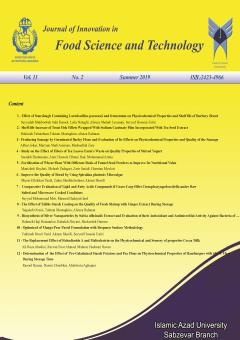Subject Areas :
لیلا ناطقی 1 , محبوبه سادات رسول 2 , علیرضا شهاب لواسانی 3 , سید حسین استیری 4
1 - عضو هیات علمی تمام وقت دانشگاه آزاد اسلامی - واحد ورامین پیشوا
2 - دانشگاه آزاد اسلامی واحد ورامین پیشوا
3 - دانشگاه آزاد اسلامی،واحد ورامین پیشوا،گروه علوم و صنایع غذایی ، ورامین- ایران
4 - گروه علوم و صنایع غذایی،واحد سبزوار،دانشگاه آزاد اسلامی، سبزوار
Keywords:
Abstract :
15.AACC. 2000. Approved methods of the American association of cereal chemists (methods, 10-05, 44-14, 74-09, 74-30). St. Paul, Minnesota: American Association of Cereal Chemists.
16.Arendt, E.K. Ryan, L.A.M. and Bello, F.D. 2007. Impact of sourdoughon the texture of bread. Food Microbiology, 24(2): 165-174.
17..Baker, J. C., Parker, H. K. and Fortmann, K. L. 1953. Flavour of bread. Cereal Chemistry, 30: 22-30.
18.Corsetti, A.. Gobbetti, B., De Marco, B., Balestrieri, F., Paoletti, F. and Rossi, J. 2000. Combined effect of sourdough lactic acid bacteria and additives on bread firmness and staling. Journal of Agricultural and Food Chemistry, 48:3044-3051.
19.Clarke, C.I., Schober, T.J. and Arendt, E.K. 2002. The effect of single strain and traditional mixed strain starter cultures on rheological properties of wheat dough and bread quality.Cereal Chemistry, 79: 640-647.
20..Elke,K.., laam, A., Ryan, A.M. and Dal Bello,F. 2006. Impact of sourdough on the texure bread . food Microbiolgy, 24(2):165-174.
21.Gargari, BP., Mahboob, S. and Razavieh, SV. 2007. Content of phytic acid and its mole ratio to zinc in flour and breads consumed in Tabriz, Iran.
Journal of Food Chemistry, 100(3): 1115-119.
22.Gul, H., zcelik, S., Sagdic, O. and Certel, M. 2005. Sourdough bread production with lactobacilli and saccharomycescerevisiae isolated from sourdoughs. Process Biochemistry, 40, 691-697.
23.Korakli, M., Rossmann, A., Gänzle, G. and Vogel, R.F. 2001. Sucrose metabolism and exopolysaccharide production in wheat and rye sourdoughs by Lactobacillus sanfranciscensis .Journal of Agricultural and Food Chemistry impact factor, 49, 5194-5200.
24.Katina, K., Arendt, E., Liukkonen, K.H., Autio, K., Flander, L.and Poutanen, K. 2005. Potential of sourdough for healthier cereal products. Trends food science and technology, 16, 104-112.
25.Mikelsaar, M. and Zilmer, M. 2009. Lactobacillus fermentum ME-3 An antimicrobial and antioxidative probiotic . Microbial Ecology in Health and Disease, 21(1): 1-27.
26.Plessas, S., Bekatorou, A., Gallanagh, J., Nigam, P., Koutinas, AA. and Psarianos, C. 2008. Evolution of aroma volatiles during storage of sourdough breads madeby mixed cultures of luyveromyces marxianus and Lactobacillus delbrueckii ssp. bulgaricus or Lactobacillus helveticus. Food Chemistry., 107:883-889.
27.Randazzo, CL., Restuccia, C., Romano, AD. and Caggia, C. 2004. "Lactobacillus casei, dominant species in naturally fermented Sicilian green olives". International Journal of Food Microbiology, 90(1): 9–14.
28.Robert, H., Gabriel, V., Lefebvre, D., Rabier, P., Vayssier, Y. and Faucher, C. 2006. Study of the behaviour of Lactobacillus plantarum and Leuconostoc starters during a complete wheat sourdough bread making process. LWT- food science and technology, 39, 256-265.
29.Rehman, Ur., Nawaz, H. S., Hussain. and Ahmad, M.M. 2007. Effect of sourdough bacteria on the quality and shelf life of bread. Pakistan Journal Nutrition, 6 (6): 262-265.
30Wehrle, K..,Crau, H. and Arendt, E. 1997. Effects of lactic acid, acetic acid and table salt on Fundamental rheological dough properties of wheat dough. Cereal chemistry, 74, 739-744.
31.Zlateva, D. and Karadzhov, G. 2008. Sensory quality of bread prepared with leavens of lactic acid bacteria and added amino acids. Forum Ware International, 1, 50-57.


